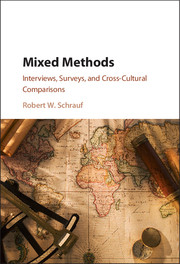Book contents
- Mixed Methods
- Mixed Methods
- Copyright page
- Contents
- Figures
- Tables
- Preface
- Acknowledgments
- 1 Mixed Methods Cross-Cultural Research and Discourse
- 2 Four Empirical, Mixed Methods Cross-Cultural Comparisons
- 3 Language and the Interactional Emergence of Cultural Meanings
- 4 From Interactional Events to Transcripts and Spreadsheets
- 5 Language(s), Translation(s), and Bilingual(s)
- 6 Worked Example
- 7 Cross-Cultural Survey Response and the Sociocultural Field
- 8 Worked Example
- 9 Cross-Cultural Interviews
- 10 Worked Example
- 11 Mixed Methods Cross-Cultural Comparison
- References
- Index
- References
References
Published online by Cambridge University Press: 06 January 2017
- Mixed Methods
- Mixed Methods
- Copyright page
- Contents
- Figures
- Tables
- Preface
- Acknowledgments
- 1 Mixed Methods Cross-Cultural Research and Discourse
- 2 Four Empirical, Mixed Methods Cross-Cultural Comparisons
- 3 Language and the Interactional Emergence of Cultural Meanings
- 4 From Interactional Events to Transcripts and Spreadsheets
- 5 Language(s), Translation(s), and Bilingual(s)
- 6 Worked Example
- 7 Cross-Cultural Survey Response and the Sociocultural Field
- 8 Worked Example
- 9 Cross-Cultural Interviews
- 10 Worked Example
- 11 Mixed Methods Cross-Cultural Comparison
- References
- Index
- References
- Type
- Chapter
- Information
- Mixed MethodsInterviews, Surveys, and Cross-Cultural Comparisons, pp. 238 - 256Publisher: Cambridge University PressPrint publication year: 2016

